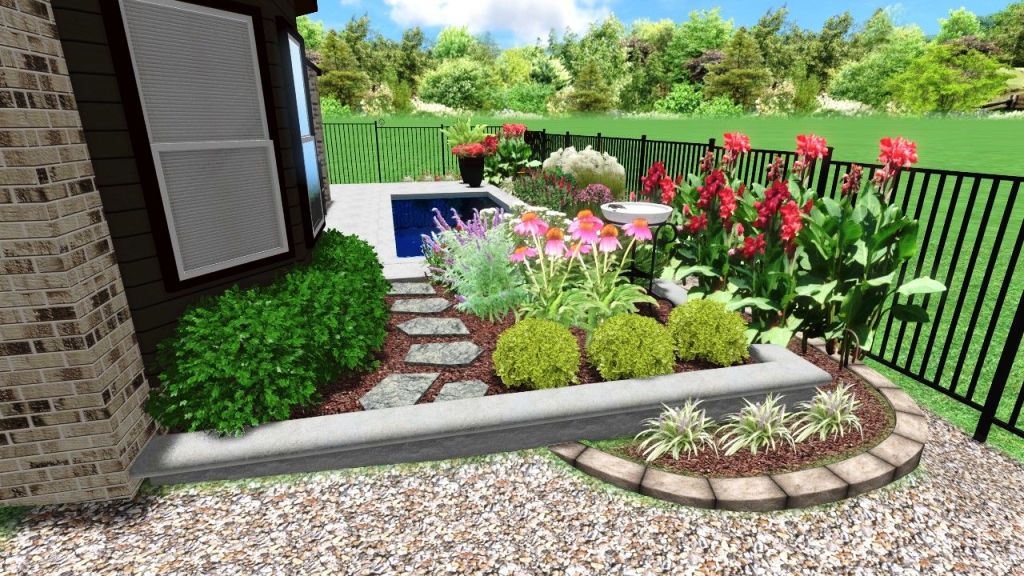
mainstreetlawn
Stepping Stone Walkway Ideas (Side of House)
Side yard areas have become of increasing landscaping significance in the North Texas area. With a substantial number of homes in our area being built close to our neighbors, the side of a house is often the site of dying grass, has unsightly utilities and poor drainage areas requiring drainage corrections.
Since most all side yards are being used to travel from the front yard to the backyard, some common landscaping solutions are installing artificial grass, planting new sod or creating a stepping stone walkway along the side of a house using a variety of stone, rock and concrete.
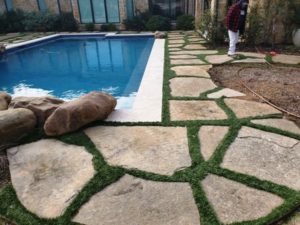
Flagstone Step Walkway
One of the simplest ways to achieve a stepping stone walkway is to simply lay down flagstone. Flagstone is a natural stone found in a variety of colors and irregular shapes and various thicknesses.
For a flagstone step walkway path, you should select flagstone with at least a 1.5 inch thickness or greater, similar to those used to install a stone patio. If you plan to install them in grass, simply set the flagstone down and cut around the stone. Once you have cut the basic shape of the stone in the grass, remove the stone and start shoveling out the grass. Once the grass is removed, replace the stone. You should plan to place the flagstone about 1 ft to 1.5 ft apart to create a natural stepping distance.
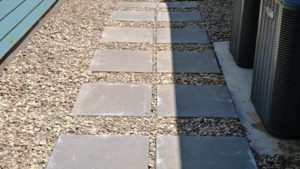
Paver Stepping Stones
If you prefer a more uniform shape for your stepping stones, another great option would be to install paver stepping stones. Most pavers are fabricated using concrete and come in a variety of shapes, sizes and colors. Pavers like those used in stone patio installations are best because they’re thick and dense to provide durability (between 1.5 – 2.5 inches thick).
You can also purchase travertine or marble in a paver thickness if you prefer a more natural look. Similar to installing flagstone in grass, you will lay the paver directly on the grass, cut the shape and then dig out the underlying grass before replacing the paver.
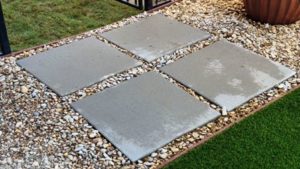
Concrete Stepping Stones
Perhaps you prefer a more permanent, larger stepping stone. If that’s the case, consider having concrete stepping stones poured directly in place. While pouring concrete will certainly add to the overall cost, they will be the most durable option and can be custom designed to your landscape style and even made to match other decorative stamped concrete surfaces such as patios or driveways.
If you plan to create these stepping stones on your own, you will need to create a wooden form in the shape of the finished stepping stone. Plan to dig out the grass and soil to allow for a 4 inch depth of concrete. Once you have excavated and installed the form, you will want to install rebar to strengthen the concrete and protect against cracking. Once the concrete has been poured and finished, remove the form and move on to the next one. Concrete needs to cure, so plan to lightly water it daily for the first week, allowing it to cure slowly.
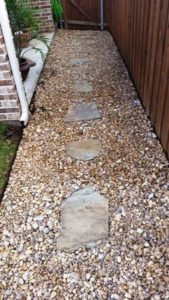
River Rock Pebble Path
Oftentimes side of house areas experience tremendous lack of sunlight or drainage issues and grass is no longer an option. Adding a river rock pebble path to a side yard area provides landscaping interest as well as enhanced drainage.
The first thing you will want to do is eliminate any existing weeds or grass from the area. You can do this by manually removing it or applying a grass and weed killer. Once the grass and/or weeds have been removed, lay down a landscaping weed barrier fabric to cover the entire area you plan to add river rock.
To define your pathway and keep the river rock confined, install an edging material. This edging can be found in a variety of colors and materials. You can install metal edging borders, composite bender board or use natural stonework.
Once you have created your pathway base and borders, simply install the river rock to create your pathway. If you want to enhance the pathway with stepping stones, install them before you add the river rock.
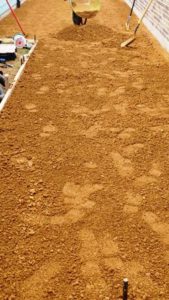
Decomposed Granite Pathway
Another fantastic material for pathways is decomposed granite. Somewhere between gravel and sand, decomposed granite can be compacted to create a solid surface that is not only pleasant to look at, but facilitates drainage and is easy to navigate.
Similar to the installation process for a river rock pathway, you will need to eliminate any remaining grass and weeds from the installation area, install a landscaping fabric and define the edges of your pathway. Feel free to install stepping stones to enhance the decomposed granite pathway as well.
Finally install your decomposed granite in the landscaped area. If you would like to enhance the strength and stability of your decomposed granite pathway, install 2 inches of material, then apply water to the decomposed granite and compact it with either a hand tamper or plate compactor. Once compacted, install an additional 1-2 inches of decomposed granite and compact again.
There’s no shortage of stepping stone walkway ideas and materials out there to turn an unsightly side yard into a pathway with purpose and style.
Share this post
© 2024 · Main Street Lawn Care and Landscaping, LLC

